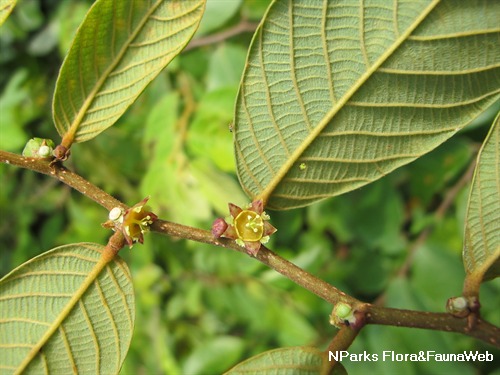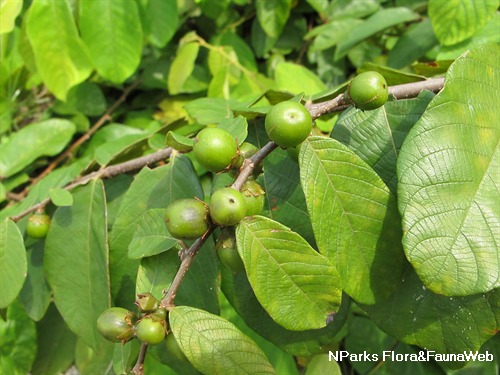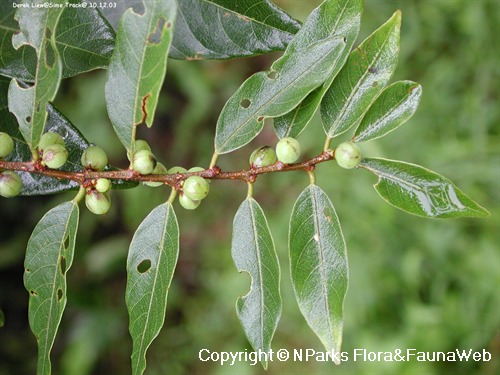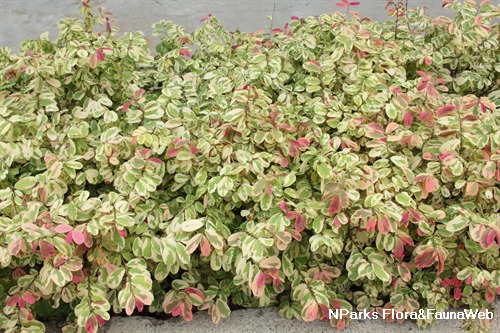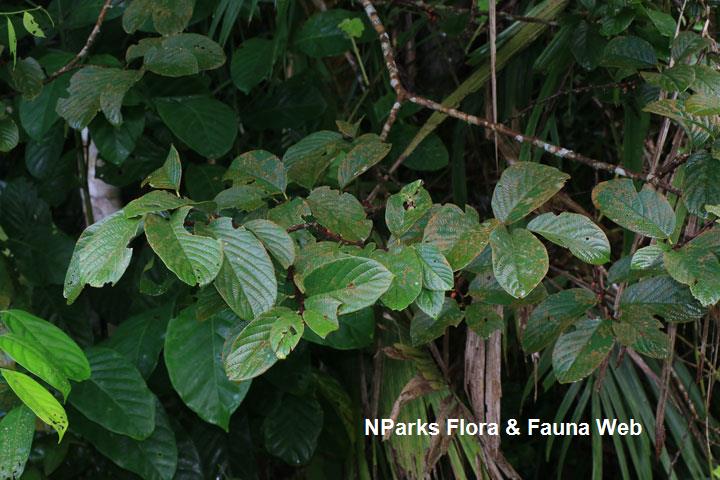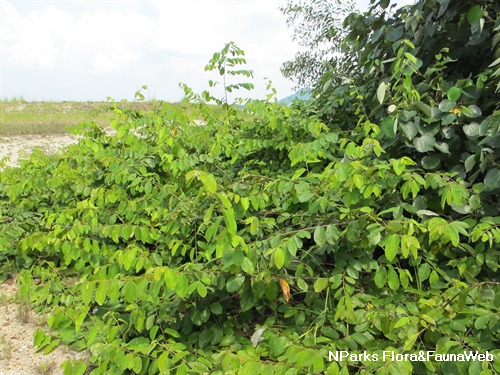
Back
Bridelia stipularis (L.) Blume
| Family Name: | Phyllanthaceae |
| Synonyms: | Bridelia scandens |
| Common Name: | Kenidai, Kernam, 土蜜藤 |
Name
Classifications and Characteristics
| Plant Division | Angiosperms (Flowering Seed Plants) (Dicotyledon) |
|---|---|
| Plant Growth Form | Climber, Shrub |
| Lifespan (in Singapore) | Perennial |
| Mode of Nutrition | Autotrophic |
| Plant Shape | Irregular |
| Maximum Height | 8 m |
Biogeography
| Native Distribution | Southern China, India, Sri Lanka, Nepal, Thailand, Sumatra, Peninsular Malaysia, Singapore, Philippines, Borneo, Java and Lesser Sunda Islands |
|---|---|
| Native Habitat | Terrestrial (Primary Rainforest, Secondary Rainforest, Freshwater Swamp Forest, Riverine), Shoreline (Mangrove Forest, Sandy Beach) |
| Preferred Climate Zone | Tropical |
| Local Conservation Status | Native to Singapore (Least Concern (LC)) |
Description and Ethnobotany
| Growth Form | It is a woody scrambling shrub or climber, up to 8 m in height. |
|---|---|
| Foliage | Its alternate, stalked leaves have papery to slightly leathery leaf blades that are elliptic, drop-shaped to round, and 4-17 by 2-11 cm. Its veins are prominent below. |
| Flowers | Its flowers grow in clusters of 2-6, often along leafless branches or along branches with small leaves. Its male flowers are cream to greenish or yellowish and 0.6-1 cm across, while its female flowers are reddish-green and up to 12 mm across. |
| Fruit | Its fruits are ellipsoid to slightly round or egg-shaped, dull dark reddish to black, 0.7-1.3 by 0.6-1.1 cm, and grow in clusters of 1-5. Its seeds are yellow to brown, somewhat egg-shaped, and 6-8 by 3-6 mm. |
| Habitat | Grows on sandy soil, limestone or loam, in primary and secondary forests, often near wet places such as rivers, swamps, seashore and mangroves, up to 400 m altitude. |
| Associated Fauna | Preferred local food plant for caterpillars of various moth species - Acrocercops quadrisecta; Corcyra cephalonica; Dichomeris petalodes; Endoclita malabaricus; Gargetta costigera; Leucoptera loxoclista; Lobesia rhombophora; Lophoptera illucida; Stigmella clinomochla |
| Etymology | Bridelia, commemorating Professor S. E. Bridel (1761 - 1828); Latin stipularis, having stipules. |
| Ethnobotanical Uses | Edible Plant Parts : Edible Fruits, Edible Seeds Food (Fruit or Vegetable): Its fruits are edible and its seeds yield a fatty oil. Medicinal: Roots are used as medication to reduce inflammation. Its bark and leaves have medicinal properties. Timber & Products: Bark is used for tanning and fruits are used are dyeing black. Others: Its fruits are used for dyeing black. Its bark is also used in tanning. |
Landscaping Features
| Landscaping | It may be suitable for parks. |
|---|---|
| Desirable Plant Features | Ornamental Foliage |
| Landscape Uses | Parks & Gardens, Coastal, Riverine |
Fauna, Pollination and Dispersal
| Fauna Pollination Dispersal Associated Fauna | Caterpillar Moth Food Plant (Leaves) |
|---|---|
| Pollination Method(s) | Biotic (Fauna) |
| Seed or Spore Dispersal | Biotic (Fauna) |
Plant Care and Propagation
| Light Preference | Full Sun, Semi-Shade |
|---|---|
| Water Preference | Moderate Water |
| Plant Growth Rate | Fast |
| Rootzone Tolerance | Moist Soils, Well-Drained Soils, Fertile Loamy Soils |
| Propagation Method | Seed |
Foliar
| Foliage Retention | Evergreen |
|---|---|
| Mature Foliage Colour(s) | Green |
| Mature Foliage Texture(s) | Papery, Leathery |
| Foliar Modification | Stipule |
| Foliar Type | Simple / Unifoliate |
| Foliar Arrangement Along Stem | Alternate |
| Foliar Attachment to Stem | Petiolate |
| Foliar Shape(s) | Non-Palm Foliage (Obovate, Elliptical) |
| Foliar Venation | Pinnate / Net |
| Foliar Margin | Entire |
| Foliar Apex - Tip | Acute |
Floral (Angiosperm)
| Flower & Plant Sexuality | Unisexual Flowers , Monoecious |
| Flower Colour(s) | Yellow / Golden, Red, Green - Light Green, Cream / Off-White |
|---|
| Flower Grouping | Cluster / Inflorescence |
| Flower Location | Axillary |
| Flower Symmetry | Radial |
Fruit, Seed and Spore
| Mature Fruit Colour(s) | Red, Black |
|---|---|
| Fruit Classification | Simple Fruit |
| Fruit Type | Fleshy Fruit , Non-Accessory Fruit |
| Mature Seed Colour(s) | Brown, Yellow / Golden |
Image Repository
Others
| Master ID | 31862 |
|---|---|
| Species ID | 6263 |
| Flora Disclaimer | The information in this website has been compiled from reliable sources, such as reference works on medicinal plants. It is not a substitute for medical advice or treatment and NParks does not purport to provide any medical advice. Readers should always consult his/her physician before using or consuming a plant for medicinal purposes. |

